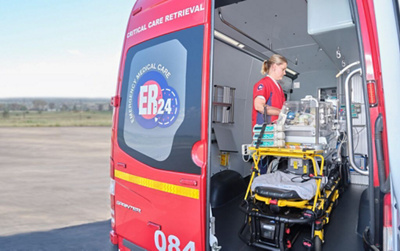ER24’s Critical Care Retrieval Services (CCRS) teams transport critically ill patients from one facility to another that’s better equipped to deal with their medical needs.
Around 70% of calls involve neonatal (newborn) and paediatric patients.
Saving lives
ER24 Specialised CCRS ILS crew member Stefan van Tonder recalls an incredibly special invitation he recently received. “It was for the first birthday party of twin girls,” he says. “These premature babies had been born at 27 weeks, and our CCRS teams were tasked with transporting them from one hospital to another specialist facility for specialised surgery.”
Van Tonder and his partner, ER24 Emergency Care Practitioner Charl Rautenbach, were equipped to deal with more than the highly specialised needs of their fragile patients – they had the compassion and insight to care for the distraught parents too. The twins needed to complete this trip seven times over a few weeks. “The fact that they reached their first birthday is amazing,” says Van Tonder, who played a key role in their survival as part of the CCRS team.
ER24’s Critical Care Retrieval Services
ER24’s Critical Care Retrieval Services (CCRS) comprises two ground ICU ambulances – one in Johannesburg (staffed by a team of six) and one in Cape Town (with a team of four). There are also four fixed-wing aircraft, configured as specialised air ambulances, all based in Johannesburg. These are owned by Guardian Air, which also supplies the pilots, while ER24 supplies the medical teams and equipment. The highly qualified medical staff at ER24’s Contact Centre assess and manage complex interfacility transfers and the ground ICU dispatch. A dedicated flight desk manages the dispatch of the ER24 air ambulances.
Special needs of premature babies
“Each specialised mobile unit operates as an ICU on wheels, designed and equipped to deal with complex, sick patients,” says Maryna Venter, an Emergency Care Practitioner and ER24’s Critical Care Retrieval Services Manager. “They are fitted with advanced, specialised equipment and the interior space is bigger than standard operations ambulances.”
Premature babies are very fragile, she adds, which makes them extremely susceptible to the impact of an adverse environment. “If you use sub-optimal equipment or transport them in sub-optimal conditions, it can have a lifelong impact. For example, they can end up with chronic lung damage if they’re ventilated with inadequate ventilators. “The risk of infection is very high, and many premature babies die of sepsis, so being able to maintain a clean, sterile environment is key.”
To this end, specialised ventilators in the CCRS units have full ICU mode capability, including specialised neonatal modes designed to assist premature babies and neonates (babies younger than a month) to breathe.
State-of-the-art equipment
Another difference is the active humidification capability in ER24’s ICU ambulances. With operational transport ventilators, cold, dry oxygen moves in a straight circuit from the ventilator to the patient. “However, when we intubate a 500g baby, cold and dry oxygen would lower their body temperature and damage their lungs. With the ICU ventilator, oxygen goes into a chamber that sits on a heated platform with specialised fluid. The air passes through the heated fluid, as well as a heated circuit limb and heat and moisture is added to limit any potential lung damage.”
The units are also equipped with portable blood gas analysis, enabling ER24 CCRS paramedics to draw a blood sample and analyse it for oxygen levels, CO2 levels, electrolytes and more. “In the air ambulance environment, we fly across the African continent, its surrounding islands, as well as into Europe and the UK. We often fly for extended periods with critically ill patients, without the availability of laboratory blood results,” Venter explains. “The portable analysis option leads to better patient outcomes because the test results are immediate and inform our treatment accordingly.”
In addition, ER24’s mobile ICU also boasts up to 12 multiple infusion devices. This means the CCRS teams can administer multiple medications to a patient over a continued period. These might be to support the heart, blood pressure and kidneys, or they could be anaesthetic medications to keep the patient sedated while on the ventilator. Specialised incubators for neonates, and electronic self-loading stretchers for adults are two more ways these state-of-the-art ambulances differ from standard road ops vehicles.
Rewarding work
“Critical care retrieval can be incredibly rewarding,” Venter says. “But it can also be incredibly stressful and emotionally draining. We see a high ratio of premature or otherwise critically ill neonates [babies], so the emotional load is high. It can be a tough balancing act trying to stay calm and reassuring when a new mother’s stress levels are rising. “However, knowing we form a link in the care of a patient who would otherwise not survive is what makes it all worthwhile.”



